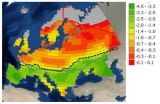(Press-News.org) The study, published yesterday in the journal Ecology Letters, analyzed the species richness and the structure of their communities throughout the different regions of the European territory from the Ural Mountains to the Iberian Peninsula. The selection of this family of insects was motivated by their high dispersal ability and because their food sources (mainly cattle and sheep dung) are present throughout the continent.
Research by the Spanish National Research Council reveals that the large impacts occurred during the last ice age maintain their
effects on the current distribution of dung beetles of the scarab family. The presence of these beetles in Europe seems to be more influenced by the climate of that glaciation than by the present one.
Scarabs are insects of tropical origin that cannot survive below 0 ° C mean annual temperature, "so it could be expected that their presence gradually decreases as temperatures drop down northwards " says the researcher from the National Museum of Natural Sciences, CSIC, Joaquín Hortal. However, the analysis of the relationship between the magnitude of climate change since the last glaciation and the distribution of scarabs evidences that these insects are not evenly distributed according to this gradient, but rather show two different patterns, one in the north and one in the south. Horton said: "The border defining the two areas is almost similar to the limit of 0 °C of mean annual temperature at the time of the last ice age." (See Figure 1)
Although scarab species richness is actually lower in the north that in the south, another two characteristics can be explained under the hypothesis of the influence of the last ice age.
The first one is based on the species present throughout Europe. Data show that all scarab species living in the northern territory above the border defined by the 0 ° C limit in the last glaciations are also present in the south, and there is no species exclusive to the northernmost area. According to Hortal, "this is an effect of the difficulty of adapting to cold climate that still exists, as the north does not hold unique species adapted to the cold."
This feature is consistent with the second observation, based on the age of the species present in each area. The study results show that the species that have been able to re-colonize the north are also those that have evolved most recently." Although the adaptation to cold climates started before the last glaciation, these species belong to the newer phylogenetic branches of the Scarabaeidae," says the researcher from CSIC.
Joint influence
The current distribution of scarabs in Europe demonstrates, therefore, that certain influence of the last ice age is still maintained. According to Hortal, "it is not that the current climate does not affect biodiversity, but rather that the impact of past climate change is hiding under the influence of present conditions." The reason why such impact has not been detected so far is that both cause similar effects, i.e., less species in the North of Europe. The CSIC researcher says that: "current biodiversity patterns are therefore a mixture of past climate effects, current conditions and the evolutionary history of the species."
The results of this investigation show that the consequences of major climate changes persist over a very long term. According to Hortal, "this work should be taken into account when analyzing and forecasting the consequences of the global warming currently experienced by the Earth." The researcher concludes: "If the temperature continues to rise, some climates that never occurred during the recent history of our planet may appear, and we do not know which species, both animal and plant, will be able to adapt to them; in fact, it is possible that many of them will not be able to live in these new climates."
INFORMATION:
Hortal, J., Diniz‐Filho, J. A. F., Bini, L. M., Rodríguez, M. Á., Baselga, A., Nogués-Bravo, D., Rangel, T. F., Hawkins, B. A. & Lobo, J. M. (2011). Ice age climate, evolutionary constraints and diversity patterns of European dung beteles. Ecology Letters. DOI: 10.1111/j.1461‐0248.2011.01634.x
Glaciations may have larger influence on biodiversity tan current climate
The last glacial maximum, which occurred 21,000 years ago, effects the current distribution of European scarab dung beetles; according to CSIC research, these results could help understanding the consequences of current climate change
2011-06-09
ELSE PRESS RELEASES FROM THIS DATE:
Scale helps to measure the utility of genetic counseling in tackling fear of cancer
2011-06-09
When a person has a family history of cancer, their worry about developing the disease may lead to them refusing to have preventive tests. Advice from genetic counselling units reduces their anxiety but, until now, nobody knew how much. Now, a scientific team has validated the 'Escala de Preocupación por el Cáncer - EPC' (equivalent of the Cancer Worry Scale), the first of its kind in the Spanish language, in order to evaluate it.
"Excessive concern about cancer can result in two kinds of behaviour. Some people undergo excessive and unnecessary diagnostic tests, while ...
German National Academy of Sciences Leopoldina submits statement on energy research
2011-06-09
The German National Academy of Sciences Leopoldina has submitted an ad-hoc statement on energy research to Prof. Annette Schavan, the German Federal Minister of Education and Research. Against the backdrop of the events in Fukushima, the statement contains twelve key declarations that mainly address research-policy issues connected to the restructuring of Germany's energy system.
The German National Academy of Sciences Leopoldina compiled the statement, entitled "Energiepolitische und forschungspolitische Empfehlungen nach den Ereignissen in Fukushima" (Energy- and research-policy ...
Treating children's eye infections without surgery
2011-06-09
PROVIDENCE, R.I. – Researchers from Hasbro Children's Hospital in Providence, R.I., report that medical management may be preferred over surgery for children with orbital cellulitis, an acute infection of the tissues surrounding the eye. They have determined the criteria for surgical intervention should be dependent upon the size of a subperiosteal abscess (SPA). The research is published in the journal Ophthalmic Plastic & Reconstructive Surgery and is now available online in advance of print.
Orbital cellulitis is most often the result of bacteria from a sinus infection, ...
Flooding of farmland does not increase levels of potentially harmful flame retardants in milk
2011-06-09
As millions of acres of farmland in the U.S. Midwest and South recover from Mississippi River flooding, scientists report that river flooding can increase levels of potentially harmful flame retardants in farm soils. But the higher levels apparently do not find their way into the milk produced by cows that graze on these lands, according to a study in the ACS journal Environmental Science & Technology.
Iain Lake and colleagues note that the flame retardants, called PBDEs, are found in a variety of household products including furniture upholstery, textiles, cars, plastics, ...
Poplar tree leaf bud extract could fight skin aging
2011-06-09
Antioxidants are popular anti-aging ingredients in skin creams, and now scientists are reporting a new source of these healthful substances — leaf buds of poplar trees. Their study appears in the ACS' Journal of Agricultural and Food Chemistry.
Xavier Vitrac and colleagues note that there's a long history of using poplar buds to treat various health problems, such as colds, sinusitis, sunburn and arthritis. A substance found in beehives that is made from poplar buds (called propolis) also appears to have similar disease-fighting benefits. Propolis' effects seem to be ...
Progress in tissue engineering to repair joint damage in osteoarthritis
2011-06-09
Medical scientists now have "clear" evidence that the damaged cartilage tissue in osteoarthritis and other painful joint disorders can be encouraged to regrow and regenerate, and are developing tissue engineering technology that could help millions of patients with those disorders. That's the conclusion of a new analysis of almost 100 scientific studies on the topic, published in ACS's journal Molecular Pharmaceutics.
Tong Cao, Wei Seong Toh and colleagues point out that damage to so-called articular cartilage — the smooth, white, rubbery tissue that covers and cushions ...
What to do with bisphenol A: Ban it, restrict it, leave it alone?
2011-06-09
Despite years of scientific studies, reports, lawsuits, congressional inquiries, claims and counterclaims, the question of whether bisphenol A (BPA) poses health threats to people lacks a definitive answer, according to a package of articles on the controversial substance in the current edition of Chemical & Engineering News (C&EN), ACS's weekly newsmagazine.
In the articles, C&EN Senior Correspondent Stephen K. Ritter explains that BPA has been used in an array of consumer goods since the 1950s. Today it is a mainstay ingredient in hard plastics in some reusable drink ...
Ordered fear plays a strong role in market chaos
2011-06-09
COLLEGE PARK, MD (June 8, 2011) -- When the current financial crisis hit, the failure of traditional economic doctrines to provide any sort of early warning shocked not only financial experts worldwide, but also governments and the general public, and we all began to question the effectiveness and validity of those doctrines.
A research team based in Israel decided to investigate what went awry, searching for order in an apparently random system. They report their findings in the American Institute of Physics' journal AIP Advances.
The novelty of their study is the ...
Shop. Prep. Cook. Taste.
2011-06-09
Dick Patrick Studios releases new "Shop, Prep, Cook, Taste" Promo Book.
Dick Patrick Studios has teamed up with designer Garrett Owen to create a new promo piece entitled "Shop, Prep, Cook, Taste." The goal of the brochure is to showcase Patrick's holistic approach to shooting food photography by breaking down the food industry into its four component parts and illustrating them with photography.
Each dish in the piece has a unique story all its own, and Patrick uses his skills with the camera to bring every step in the food preparation process ...
An alternative to antibiotics
2011-06-09
More and more pathogens are becoming immune to antibiotics. Some bacteria can no longer be combated. The World Health Organization WHO is warning about resistance to drugs which were once so potent. The WHO's director-general Margaret Chan has pointed out that if measures are not taken quickly, it may soon not be possible to treat many frequently occurring infections. Figures released by the WHO show that in 2010 nearly half-a-million people were infected with a strain of tuberculosis which is resistant to many antibiotics – one third of those infected died. The Organization ...
LAST 30 PRESS RELEASES:
Neuroscientists devise formulas to measure multilingualism
New prostate cancer trial seeks to reduce toxicity without sacrificing efficacy
Geometry shapes life
A CRISPR screen reveals many previously unrecognized genes required for brain development and a new neurodevelopmental disorder
Hot flush treatment has anti-breast cancer activity, study finds
Securing AI systems against growing cybersecurity threats
Longest observation of an active solar region
Why nail-biting, procrastination and other self-sabotaging behaviors are rooted in survival instincts
Regional variations in mechanical properties of porcine leptomeninges
Artificial empathy in therapy and healthcare: advancements in interpersonal interaction technologies
Why some brains switch gears more efficiently than others
UVA’s Jundong Li wins ICDM’S 2025 Tao Li Award for data mining, machine learning
UVA’s low-power, high-performance computer power player Mircea Stan earns National Academy of Inventors fellowship
Not playing by the rules: USU researcher explores filamentous algae dynamics in rivers
Do our body clocks influence our risk of dementia?
Anthropologists offer new evidence of bipedalism in long-debated fossil discovery
Safer receipt paper from wood
Dosage-sensitive genes suggest no whole-genome duplications in ancestral angiosperm
First ancient human herpesvirus genomes document their deep history with humans
Why Some Bacteria Survive Antibiotics and How to Stop Them - New study reveals that bacteria can survive antibiotic treatment through two fundamentally different “shutdown modes”
UCLA study links scar healing to dangerous placenta condition
CHANGE-seq-BE finds off-target changes in the genome from base editors
The Journal of Nuclear Medicine Ahead-of-Print Tip Sheet: January 2, 2026
Delayed or absent first dose of measles, mumps, and rubella vaccination
Trends in US preterm birth rates by household income and race and ethnicity
Study identifies potential biomarker linked to progression and brain inflammation in multiple sclerosis
Many mothers in Norway do not show up for postnatal check-ups
Researchers want to find out why quick clay is so unstable
Superradiant spins show teamwork at the quantum scale
Cleveland Clinic Research links tumor bacteria to immunotherapy resistance in head and neck cancer
[Press-News.org] Glaciations may have larger influence on biodiversity tan current climateThe last glacial maximum, which occurred 21,000 years ago, effects the current distribution of European scarab dung beetles; according to CSIC research, these results could help understanding the consequences of current climate change




